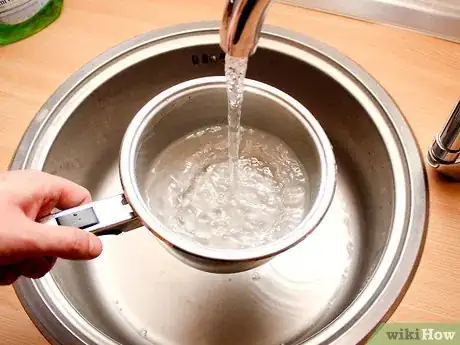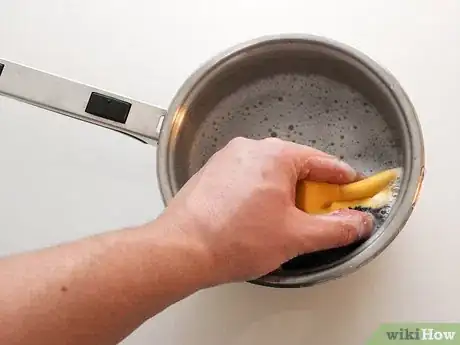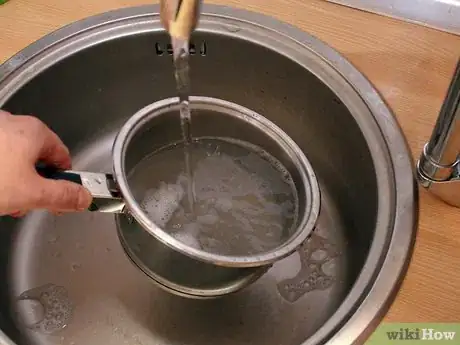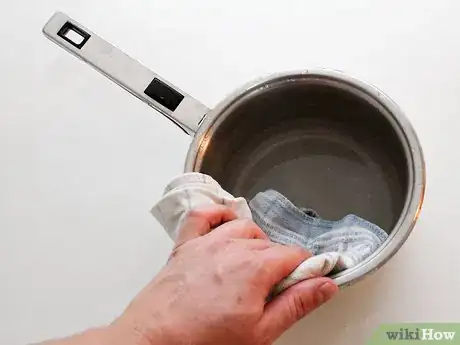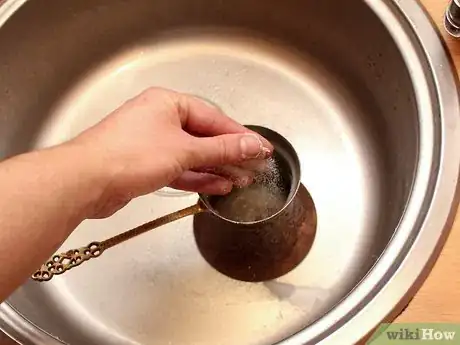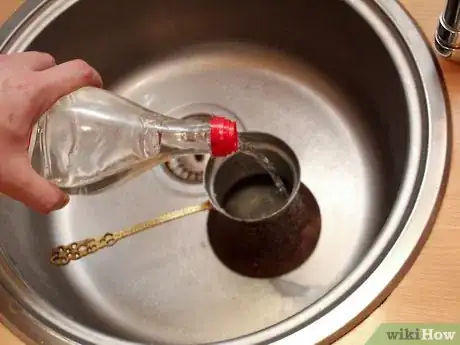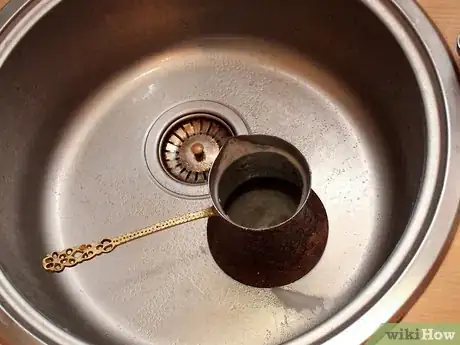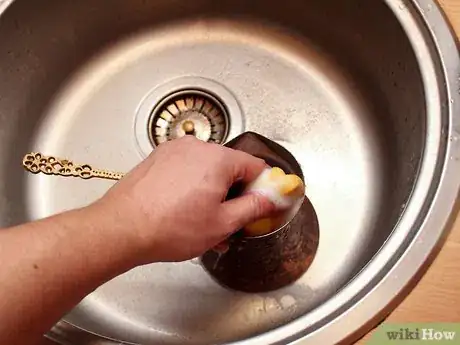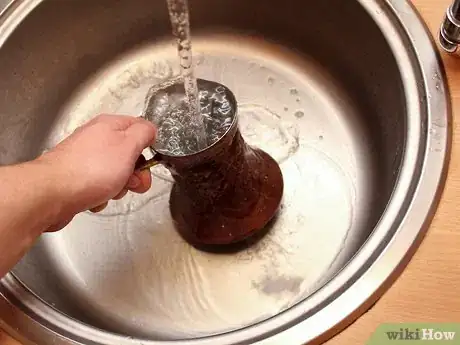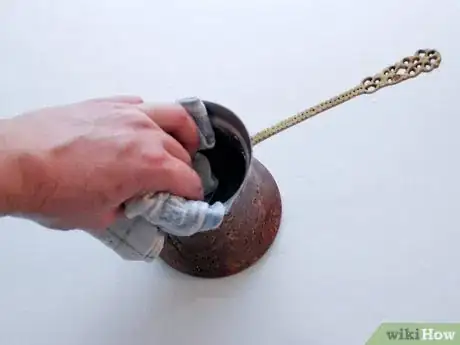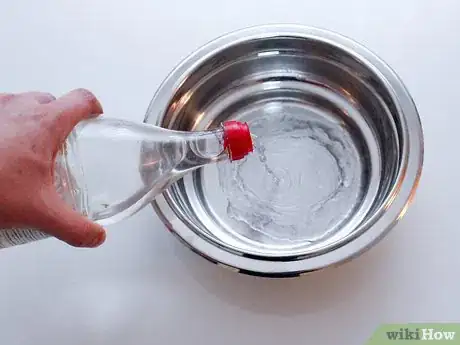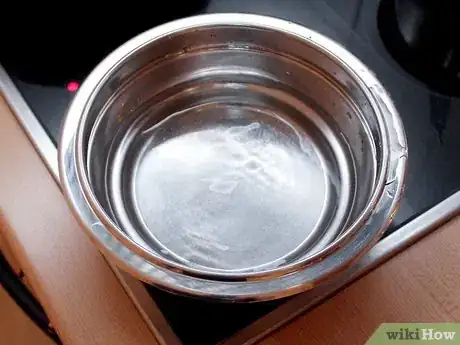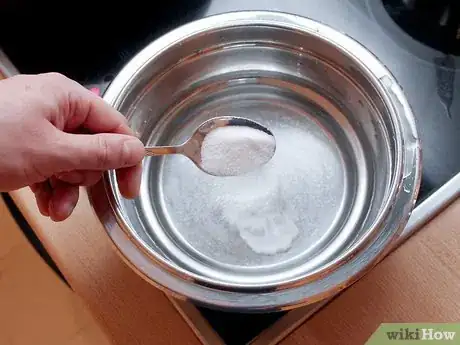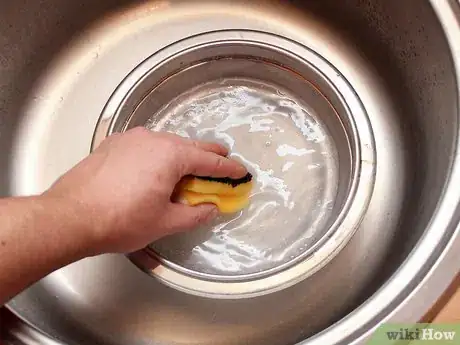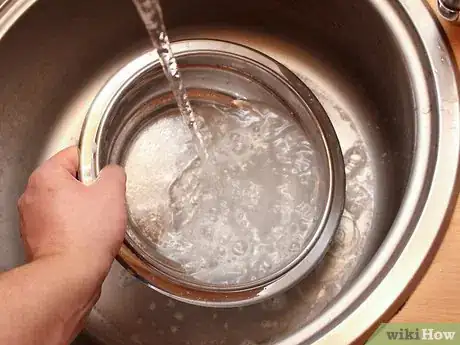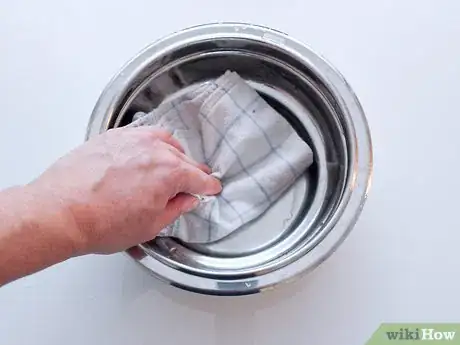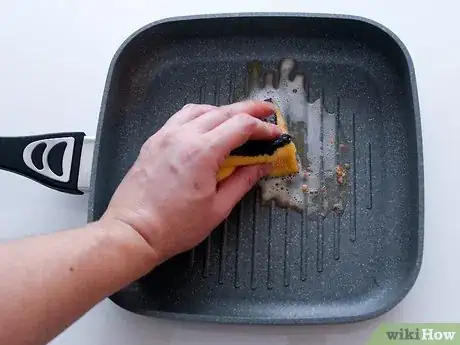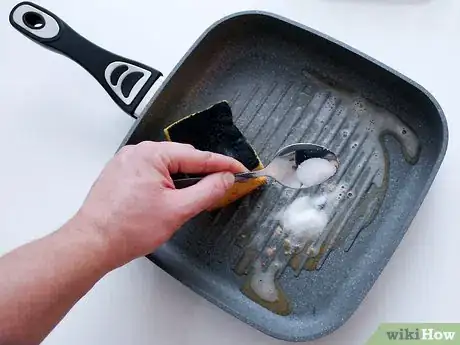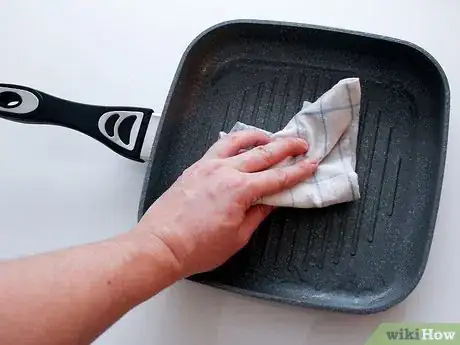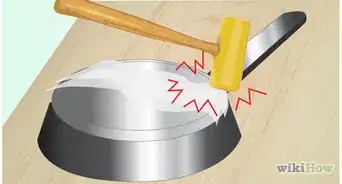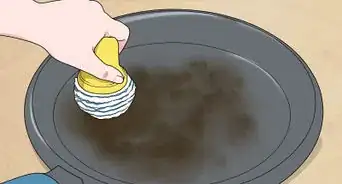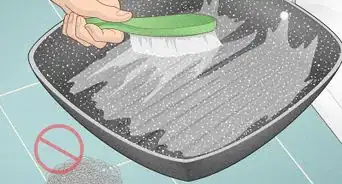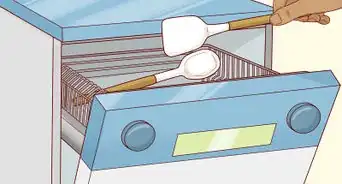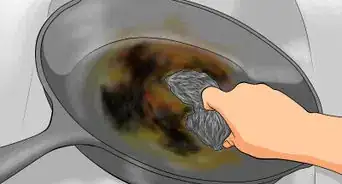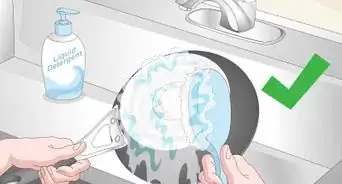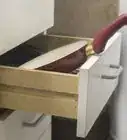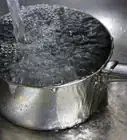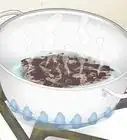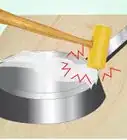This article was co-authored by Susan Stocker. Susan Stocker runs and owns Susan’s Green Cleaning, the #1 Green Cleaning Company in Seattle. She is well known in the region for outstanding customer service protocols — winning the 2017 Better Business Torch Award for Ethics & Integrity —and her energetic support of green cleaning practices.
There are 15 references cited in this article, which can be found at the bottom of the page.
This article has been viewed 35,170 times.
The longer that you let food and gunk sit on pots and pans, the harder it is to remove. You should avoid putting most types of pots and pans in the dishwasher because machine washing can scratch them and remove their protective coating.[1] Luckily, there are easy methods that you can use to clean copper, aluminum, or cast iron kitchenware with soap and water or commonly found household ingredients. With the right knowledge you'll have spotless kitchenware in no time!
Steps
Washing by Hand
-
1Fill your pot or pan ⅓ of the way with hot water. Hot water is effective at removing stuck on food and stains. You shouldn't put non-stick, cast iron, or aluminum pots and pans in a dish washer.[2]
- Putting your pots and pans in the dishwasher may scratch and damage them.
-
2Put two drops of mild dish soap in the water. Mix the soap and water together until the dish soap starts to sud. You can use dish soap on most materials like copper, stainless steel, aluminum, and non-stick pots and pans. Avoid washing cast iron with soap or it may affect the taste of your food.[3]Advertisement
-
3Scrub the inside and outside of the pot or pan with a sponge. Let hot water and soap sit in the pot or pan for a few minutes first.[4] Then, concentrate on spots that have stuck-on food or areas that are particularly dirty.[5]
- Do not use abrasive sponges or steel wool to clean non-stick or stainless steel pots because you can scratch them.
-
4Rinse the pot or pan with hot water. Hold the pot or pan under the faucet until you rinse away all the remaining soap suds. If you don't rinse your pots or pans thoroughly, your food may taste like soap.[6]
-
5Dry the pot and pan. Rub the inside and outside of the pot or pan with a rag until it's completely dry. You can also dry the pot or pan on a drying rack.
Cleaning Copper Pots and Pans
-
1Place the pot or pan in the sink and cover it in table salt. Pour enough salt on the inside and outside of the pot or pan so that there is a thin layer that covers the entire surface of the copper kitchenware. Table salt will act as an abrasive and will help you scrub problem areas on your pots and pans.[7]
-
2Pour white wine vinegar over the salt. Pour enough vinegar over the salt to wet down the pot or pan. Don't pour too much or you’ll rinse away the salt. The acidity in the vinegar will start to break down the tarnished areas in the copper.[8]
-
3Let the vinegar and salt sit on the pot or pan for 30 seconds. As the solution sits on the pot or pan, you should see tarnish and stains start to fade away. If you don’t have white wine vinegar, you can use fresh lemon juice as an alternative.[9]
-
4Scrub the pot or pan with a sponge soaked in white vinegar. Pour enough white vinegar onto a sponge to fully saturate it. Take the sponge and scrub back and forth on the inside and outside of the pot, concentrating on especially dirty spots. As you do this, dirty and tarnished areas should start to become shiny.[10]
- Sprinkle more salt on problem areas.
-
5Rinse the pot or pan with hot water. Spray down the pot or pan under the faucet until there are no more traces of vinegar or salt on your copper kitchenware.[11]
-
6Dry the pot or pan with a rag. Rub over the inside and outside of the pan, making sure to pick up all the remaining moisture from the cookware.
Cleaning Aluminum Pots and Pans
-
1Pour three parts water to one part white wine vinegar into the pot or pan. Mix the solution with a spoon or a fork until it becomes well incorporated. The acidic vinegar will clean dirty and tarnished areas on the aluminum.[12]
-
2Bring the solution to a boil on the stove top. Turn your stovetop to high and bring the mixture to a boil. Let the solution boil for a minute. Your pot or pan should already start looking cleaner.[13]
-
3Add 2 tbsps (15.62 g) of baking soda to the pot or pan. Take the kitchenware off the heat and place it into your sink. Pour the baking soda into the pot or pan. It should start to fizz and react to the vinegar and water solution. Let the baking soda sit in the pot or pan until it stops fizzing, then pour it out into your sink.[14]
-
4Scour the pot or pan with a sponge. Use a non-abrasive sponge to scour the inside and outside of the pot or pan. Add more water and baking soda to especially troublesome areas until the pot or pan looks shiny.[15]
-
5Rinse the pot or pan. Hold the pot or pan under the sink and run hot water from the faucet. Continue rinsing it until all of the baking soda and vinegar solution is removed from the pot or pan.[16]
-
6Dry the pot or pan. Wipe down the inside and outside of the pot with a cotton rag or paper towels. Continue to wipe the kitchenware until it’s completely dry.
Cleaning Cast Iron Pots and Pans
-
1Wash the pan with hot water and a sponge. Rub back and forth over the surface and interior of the pan. Take notice of places that have stuck on food. If you clean the cast iron immediately after using it, most foods will come off fairly easily.[17]
- This method of cleaning should retain the seasoning on your cast iron skillet.
- Don't soak your cast iron or leave it in the sink or it may rust.
-
2Scrub kosher salt into the pan. If there are areas on the pan that have stuck-on food, sprinkle some table or sea salt over the food and scrub it down with a sponge. The salt will act as an abrasive and will help remove the food from the pot or pan.[18]
-
3Rinse the pot or pan. Run the pan under your faucet and rinse all of the food particles off the pot or pan. If you notice that there's still stuck on food, sprinkle more salt and continue scrubbing.[19]
-
4Dry the pan thoroughly. Once the pot or pan is clean, use a cloth or rag to dry it. Remove all moisture from the cast iron before storing it.[20]
Community Q&A
-
QuestionHow do I stop watermarks forming on my polished steel pans?
 wikiHow Staff EditorThis answer was written by one of our trained team of researchers who validated it for accuracy and comprehensiveness.
wikiHow Staff EditorThis answer was written by one of our trained team of researchers who validated it for accuracy and comprehensiveness.
Staff Answer wikiHow Staff EditorStaff AnswerThe best way to prevent watermarks from forming on polished steel is to dry them quickly after washing, using a soft kitchen towel or cloth.
wikiHow Staff EditorStaff AnswerThe best way to prevent watermarks from forming on polished steel is to dry them quickly after washing, using a soft kitchen towel or cloth. -
QuestionHow can I get black stains off aluminum pans?
 wikiHow Staff EditorThis answer was written by one of our trained team of researchers who validated it for accuracy and comprehensiveness.
wikiHow Staff EditorThis answer was written by one of our trained team of researchers who validated it for accuracy and comprehensiveness.
Staff Answer wikiHow Staff EditorStaff AnswerUse lemon juice. Juice a whole lemon. Fill the stained pot or pan with water, then pour in the lemon juice. Place on the stovetop and allow to simmer over a gentle heat until you see the stains disappear. The pot should appear brighter. Repeat if necessary.
wikiHow Staff EditorStaff AnswerUse lemon juice. Juice a whole lemon. Fill the stained pot or pan with water, then pour in the lemon juice. Place on the stovetop and allow to simmer over a gentle heat until you see the stains disappear. The pot should appear brighter. Repeat if necessary. -
QuestionIs it okay to wash wooden handles in the dish water?
 wikiHow Staff EditorThis answer was written by one of our trained team of researchers who validated it for accuracy and comprehensiveness.
wikiHow Staff EditorThis answer was written by one of our trained team of researchers who validated it for accuracy and comprehensiveness.
Staff Answer wikiHow Staff EditorStaff AnswerYes, it is okay as long as you wash them quickly and dry straight after washing. Make sure to use lukewarm water only, not hot. Do not leave wooden handles in the water to soak, as this will cause them to swell, which can make them crack.
wikiHow Staff EditorStaff AnswerYes, it is okay as long as you wash them quickly and dry straight after washing. Make sure to use lukewarm water only, not hot. Do not leave wooden handles in the water to soak, as this will cause them to swell, which can make them crack.
Things You’ll Need
By Hand
- Hot water
- Dish soap
- Sponge
- Drying rack or dry rag
Copper Pots and Pans
- Table salt
- White vinegar
- Sponge
- Water
- Rag
Aluminum Pots and Pans
- Baking soda
- Vinegar
- White vinegar
- Sponge
- Water
- Rag
Cast Iron Pots and Pans
- Sponge
- Water
- Salt
- Rag
References
- ↑ http://www.thekitchn.com/things-you-shouldnt-put-in-the-dishwasher-204276
- ↑ https://money.usnews.com/money/blogs/my-money/2010/07/20/5-things-you-should-never-put-in-a-dishwasher
- ↑ https://www.bobvila.com/articles/how-to-clean-aluminum/#.WbCFBciGPcc
- ↑ Susan Stocker. Cleaning Guru. Expert Interview. 8 November 2019.
- ↑ https://www.realsimple.com/food-recipes/tools-products/cookware-bakeware/how-clean-cookware
- ↑ https://www.architecturaldigest.com/story/how-to-clean-copper-pots-and-pans
- ↑ http://www.huffingtonpost.com/2015/02/04/how-to-clean-copper-pan_n_6600468.html
- ↑ http://www.huffingtonpost.com/2015/02/04/how-to-clean-copper-pan_n_6600468.html
- ↑ http://www.thekitchn.com/how-to-clean-and-polish-copper-cooking-lessons-from-the-kitchn-216573
- ↑ https://www.architecturaldigest.com/story/how-to-clean-copper-pots-and-pans
- ↑ https://www.architecturaldigest.com/story/how-to-clean-copper-pots-and-pans
- ↑ https://www.youtube.com/watch?v=YrEqz8QZBLg&feature=youtu.be&t=8s
- ↑ https://www.apartmenttherapy.com/how-to-clean-burnt-pots-scorched-pans-140547
- ↑ https://www.apartmenttherapy.com/how-to-clean-burnt-pots-scorched-pans-140547
- ↑ https://www.mom4real.com/clean-burnt-pots-pans-natural-cleaning-trick/
- ↑ https://www.mom4real.com/clean-burnt-pots-pans-natural-cleaning-trick/
- ↑ https://www.thekitchn.com/how-to-clean-a-cast-iron-skillet-cleaning-lessons-from-the-kitchn-107747
- ↑ https://www.apartmenttherapy.com/how-to-clean-cast-iron-skillet-151535
- ↑ http://www.seriouseats.com/2016/09/how-to-clean-maintain-cast-iron-pan-skillet-cookware.html
- ↑ http://www.seriouseats.com/2016/09/how-to-clean-maintain-cast-iron-pan-skillet-cookware.html
- ↑ https://www.youtube.com/watch?v=qddGMCplL2o&feature=youtu.be&t=53s
